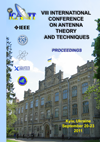Studies on radar medical sensors
DOI:
https://doi.org/10.1109/ICATT.2011.6170707Keywords:
ultra-wideband, UWB, near-field, radar, sensor, medical imagingAbstract
Ultra-wideband (UWB) radar enables detection and imaging of electrically contrast dielectric and conducting objects inside the human body that can be used to detect tumors, internal wounds and support other medical diagnosis along with mapping different metal/dielectric inclusions to navigate, e.g. a robotic surgical tool. General principles to design such systems and their building blocks are discussed along with implementation challenges. Two biomedical test radar systems are described to illustrate the study.References
TAYLOR, J.D. Ultra-wideband Radar Technology, 2nd ed. CRC Press, 2000, doi: http://dx.doi.org/10.1201/9781420037296.
STADERINI, E.M. UWB radars in medicine. IEEE Aerospace and Electron. Syst. Mag., Jan. 2002, v.17, n.1, p.13-18, doi: http://dx.doi.org/10.1109/62.978359.
BORYSSENKO, A.; BORYSSENKO, E. Principles and Methods of Materials Penetrating UWB Radar Imagery, 3rd ed. CRC Press, 2012, http://dx.doi.org/10.1201/b12356-13.
BORYSSENKO, A.; ET AL. Portable Imaging UWB Radar System with Two-Element Receiving Array. Ultra-Wideband Short-Pulse Electromagnetics, 2007, n.8, p.153-160, doi: http://dx.doi.org/10.1007/978-0-387-73046-2_21.
PASTORINO, M. Microwave Imaging. Wiley, 2010, doi: http://dx.doi.org/10.1002/9780470602492.
SALEH, B. Introduction to Subsurface Imaging. Cambridge University Press, 2011, doi: http://dx.doi.org/10.1017/CBO9780511732577.
STONE, J.V. Impendent Component Analysis. The MIT Press, 2004.

